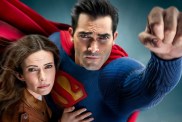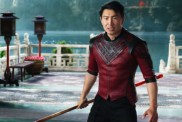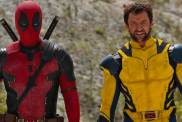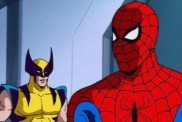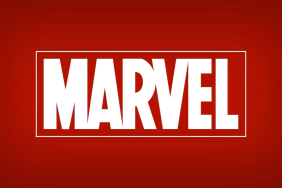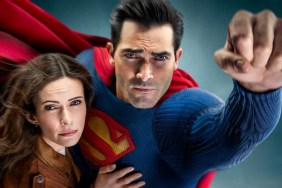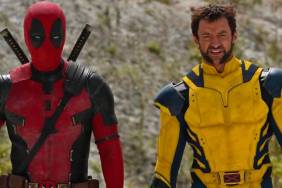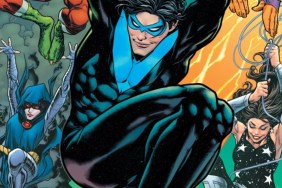Peter Sarsgaard: We shared the same glue. When I finished he was starting and my passing comment to him was, “You’re going to find that you have this thing about the glue, that you’ll dream about the glue, the smell. There’s something about it.” It’s like, “Do you really like Tang or is it just a sense memory?” I still think that sometimes, and it was kind of impossible to get that off. You’d kind of get it off. A couple of days later you’d —
Strong: Find a little nugget, yeah.
Sarsgaard: A long strand, yeah. It’s a challenge, but also I think for me as an actor on it, there were these different stages on it, right, and none of them looked like me. Even the beginning doesn’t look like me. So, it was like a gift. For one, I could tell where I was in the movie. A lot of times you’re in a movie and you’re like, “Right. We’re in the part where what happens?” I had clear stages that told me where I was in the movie, which was nice.

Campbell: Maybe, maybe. They all turn to villains, if you know the comics. Sinestro, she does. They’re all one way or another turning into villains, aren’t they?
Q: How did you all feel when you saw the final product?
Reynolds: For me it was incredible because I was shooting in basically a box for a good portion of the movie that was just blue screen and to see these guys, these immensely talented artists who are world builders, create this universe around me that I’m interacting with in a very real way was just mind blowing. I’ve never been a part of anything like that. I mean, it was a feat of engineering unto itself and that was pretty spectacular. I saw it in 3-D as well, and I was practically weeping.
Strong: Often on a movie, what you’ll do is go to see it and you’ll have forgotten what everyone else is doing in the movie. You’ll remember your parts because you shot them, but on this you actually get to see the bits that you’re in that you’d forgotten about because there’s nothing around while you’re shooting. You’re in a big blue room and every object is covered in blue or green and so it was amazing to see the environment that you were in that you were imagining and then see that realized. They’ve done such an amazing job that it’s mind blowing.
Sarsgaard: I’m glad that I’m married because I’m not going to get any dates from this movie. The thing that impresses me the most is just that when it comes right down to it, it all has to be in Martin’s head somehow. To think that there’s a lot of people doing different jobs and it’s incredibly collaborative and there’s people doing CG and scores there, but there’s a guy that has to make sure that all of those things come together, and like olive oil and garlic, turn into a third thing that’s great. I’m just extraordinarily impressed that he managed to contain this in his mind in some way. Lively: It was a very special experience for me because I got to watch this film almost as an audience member. I grew up always a fan of these comic films and I would come out wanting to fly and kick someone’s butt, and never have I seen a film I’m in where I’m able to watch it somewhat objectively. I was surprised throughout the film and cheering. It was a really cool experience to be onscreen and see the way that it came together. We saw all of the visual FX, all of the art work, all of the design, but it still seemed somehow impossible that it was just such a big undertaking. It seemed impossible that this movie would actually come out. We’ve been living with this movie for a year now, a year and a half. I can’t believe it’s actually here and I’m so excited to share it with everyone because I think it is very special.
Q: Martin and Donald, the voice talent and the other characters were amazing. How did you gather them all together?
Campbell: I think we paid them.
DeLine: It’s a strong incentive.
Campbell: Yes. Of course we had Geoffrey Rush for Tomar-Re and Michael Clarke Duncan as Kilowog. The interesting thing for me, never having done it before–Donald had with “Yogi Bear” and so forth–but it’s so interesting that even the most talented actor doesn’t actually fit the body or the character, in this case the digital character, that you’re creating. And so it’s sort of experimentation. What you do is you have to get people in to, I say, test and they make give a great performance, but it just somehow doesn’t connect with the body of the character that you’re creating. To cut a long story short, Geoffrey Rush I think is perfect for Tomar-Re as is Michael Clarke Duncan.
DeLine: Absolutely. It was a fun process because we listened to hundreds of actors and what we’d do is take an image, just a piece of artwork of either Tomar-Re or Kilowog because that’s all we had – we had no animation at the time – and put that image up on a monitor and then we had somebody in the production office who would take voice clips from various actors that we thought were interesting for the characters. Then we’d just listen to that voice clip over the image of either Tomar-Re or Kilowog just to get a sense of how a voice and a quality of timbre and all of that kind of matched up with the visual. But we’d crack up sometimes because we’d be listening to things from “Full Metal Jacket” or all kinds of films, so it was a lot of fun and it was a real discovery process, but then when that right voice gets there, just an actor inhabiting a role, it brought it to life. Geoffrey Rush. The first time we heard him do that character it was really thrilling.
Q: Donald and Martin, how did you come across Taika Waititi? He hasn’t really done anything stateside.
Campbell: I think it was our casting director. Pam Dixon who brought him in. I’m a New Zealander and to be honest I’d never heard of him.
DeLine: He directed a film called ‘Boy’ that won a big award at Sundance.
Campbell: Yes, it was a terrific film, and in he came. He’s also done a lot of television and he writes a lot. He’s a very clever guy and he just fit the character of Tom perfectly.
Sarsgaard: He did an incredible version of ‘Modern Love’, the song, one day. It was mind-blowing.
DeLine: He’s probably also the only half-Maori, half-Jewish actor in existence.
Q: Martin, what did you learn in shooting this CGI environment?
Campbell: Well, you learn an awful lot technically. I’d never done it and the only way to learn is to do it. You can’t read about it. You can’t be told about it. The point is that you have to do it. So, from the technical point of view it’s a learning curve, but really the same rules apply in terms of action and in terms of the way that you stage the scenes and so forth. To be honest, it’s very similar. Certainly in staging the action we wanted the action to be sort of tough and hard. We didn’t want Green Lantern to get up, having been slung against a wall at a hundred miles an hour, shake his head and go back into the fight. So, he does get pushed around and beaten up a little bit and really has to feel the pain as it were. In a lot of respects it’s very similar to doing ‘Bond’ or to doing any other action movie.
Q: Mark and Martin, it’s always interesting to see villains before they’re villains. Comic book fans know where Sinestro goes, but what kind of discussions did you have about how he’d be portrayed in this particular story?
Campbell: Well, it’s the origin story and so of course he was portrayed, I think, very truthfully. In fact, I’ll hand it over to Mark who can explain the character. I think it was very true to the origin story, the Hal Jordan origin story, certainly.
Strong: If you know the comics you know the direction that he goes to. It’s great to play him before he goes there. I’m not sure that’s always the case. Usually villains are just villains in these things. They’re very straightforward, and so it’s nice to have him as a hero in this one. I couldn’t really imbue him with anything to do with where he goes after this movie. But what I tried to do was give him characteristics that would lend themselves to being believable should he decide to go to the dark or the yellow side. I really couldn’t think about where the stories go. The source material is so vast there’s plenty to draw from, but I had to really just stick to the script as it was. If we do go somewhere else with it I hope that he’s a believable character that would go that way.
Q: Mark, was part of the deal for you that your role would get bigger in sequels than in this film? How did you ground this character since you’re training this guy to be a Lantern?
Strong: I couldn’t do any research on aliens because I don’t know any aliens and so I don’t really know what kind of a guy he was. All I could do was use human characteristics, and it was very obvious to me that he’s a kind of military commander type figure who’s very weary of this new Lantern and feels like his priority is the Corps. If this guy is going to be the weak link in the Corps then he’s going to have to do something about it. The way that he’s drawn, such a muscular drawing and so you had to try and bring an element of that to the way that you play him. That’s what I tried to do. As far as where we go from this film, no, no. That was never discussed. It’s there in the source material, but this was the movie that we were making.
Q: Ryan, did you have any doubt about playing this character?
Reynolds: Of course, I have trepidation in playing any role. But you don’t get into the plane unless you have a great pilot and Martin Campbell was attached and the opportunity to work with him was great. He was huge for me, but also you look at who Martin’s hired as well right from Dion Beebe who’s photographing the movie to Grant Major and Ngila Dickson and all these incredible talents that are involved. It was impossible to not want to play this guy. Also, I just wanted to learn. I just wanted to see what it was like to do a film like this. I’d never, ever done anything that involved this much postproduction and so I was excited to see how that would all pan out.
Q: Martin, what’s the difference in filming a character like Green Lantern as opposed to a Batman or a Superman? Is there a risk involved in people not knowing the character?
Campbell: I think there’s a risk involved. I think that Superman has been around a lot. Obviously, the comic has been around a long time and so have the movies. They’ve done a lot of Superman movies as they have with Batman. You can say that Iron Man was a second tier character and turned out very successfully. I simply think it’s down to the movie itself, whether people like the movie, enjoy the movie, are involved in the movie, whether it entertains. So I think from that point of view the movie has to stand alone whether or not the superhero is second tier or first tier. I think that’s irrelevant.
DeLine: I think that’s correct and I also think it was our job to educate audiences. So we had a little bit more work to do in that regard because we’re introducing something to the world that a lot of people may not be familiar with. So it’s not so much in people’s consciousness as something like Superman or Batman may have been. Obviously, as Martin said, they had done television series and series of films and they’re fairly simple kind of mythologies and worlds, I think, to grasp. ‘The Green Lantern’ is quite complicated just in terms that it’s a corps of 3600 characters and there’s a pretty complicated mythology and the way that the ring works, powered by will. There’re a lot of things that you have to wrap your head around and get into. It’s a very, very big canvas which is also what made it incredibly exciting and appealing. We were just very mindful I think, also, of saying, ‘If you’ve never heard of the Green Lantern and you’ve never read a comic, this will be just as thrilling and fun for you as a great ride an adventure and a story to follow as if you had done those things.’
Strong: I don’t think he’s a greater or lesser superhero either than Superman or Batman, but I think as was said earlier, their problems are all earthbound. So they’re much easier to film and do. Obviously, ‘Green Lantern’ deals with space and I don’t think up until now the technology has been able to catch up with the vision. So, I don’t think he’s a lesser character. I just think it’s the way that it’s been made over the years. It’s much easier to make a ‘Superman’ or a ‘Batman’ than a ‘Green Lantern’.
Q: Blake, coming from a show like ‘Gossip Girl’ and moving into a comic book movie which is more a male audience, what do you think women will get from watching this movie?
Lively: I’m always attracted to strong women, and I think that Carol is a character that, as I was saying, I wish was portrayed more on film. It’s so nice to see a woman fighter pilot up there flying this plane. I think that women will appreciate that. Someone asked me, they said, ‘This is a very modern film because now women are strong,’ and I said, ‘Women have always been strong. They’ve always been standing behind their man,’ but it’s just a new idea to see it more on film. I think that women will appreciate that, but I think that anybody who goes to a theater, you want to sit down and be transported to another world for two hours and this movie is appealing to everybody. It’s full of heart. It’s full of humor. It’s full of action, and it’s not just on planet earth, but in the entire alien galaxy. There’s tons of alien species and different planets. I don’t care who you are, but it’s going to the cinema like you were as a child and just having your imagination blown open. Also, Ryan is half-naked!
Reynolds: This just went downhill.
Q: Blake, your character is a more realistic leading lady here, more straightforward and honest. Was that you bringing yourself to it? You’re not a damsel in distress.
Lively: It was definitely written that way. That’s what was so appealing about Carol. In a lot of ways this film was much more straightforward and honest. We talked earlier about the scene where I first see Hal as the Green Lantern. In every single superhero film how on earth do they not see that this is the person they’ve known their whole life, that they’ve been intimate with and you don’t recognize him because he’s got an orange mask on his face? I think in a lot of ways we just decided to… we? I didn’t write this. I’ll take all your credit, Greg. This movie tackled those things. I think it’s a really refreshing take on such a big film full of fantasy to have those moments where you actually acknowledge what every other comic film doesn’t. That bled through to each of our characters, and then the fact that Hal is a superhero, but also very, very, very human and is flawed and doesn’t know if he wants to be a superhero. I think that’s incredibly unique and that’s where I think the story is special. You can really connect with the people at the heart of this story.
Q: Greg, even with great source material it still comes down to one movie. How did you balance pleasing the fans and writing a movie for those that don’t know this character?
Berlanti: From the very beginning when Donald and I were hashing out the story, I was sort of more of the comic book geek where I’d come in and dump all this stuff on the table. Donald would go, “Wait, wait, wait. Go through this with me again. There’s how many Lanterns?” So it was a great sort of back and forth, I think, but I think that’s also the cornerstone of what makes it so unique. Yes, it’s a superhero film and yes it’s a comic book movie, but there’s a real core philosophy to it. It’s rare in these kinds of films when you’re dealing with heroes and things like that there’s actually a philosophical kind of undercurrent. In this case it’s fear versus will. I think that’s an example of us just trying to honor that stuff and make it interesting and appealing to us. You’re kind of your own first audience in that way and you just do things and write things that you think you’d enjoy seeing. Then they get vetted along the way.
Q: Donald and Greg, the most recognizable Green Lantern character in the mass media was probably John Stewart from the “Justice League” series that aired for many years. Why did you decide to start from scratch with Hal in this film?
Berlanti: For me as a comic book fan, it was probably two separate reasons. One was that [comic book writer] Geoff Johns had really brought Hal Jordan back with ‘Rebirth’ and things like that, and when you’re sitting down and trying to honor what you feel like is the origin of the comic it felt like the right place to start the Silver Age. Hal was sort of the first Earthling that was picked to go and join the corps. So, as we constructed it, we went in and pitched the studio in terms of what the movie could be and what subsequent films could be it seemed like a very natural place to start with the hope one day of honoring the order that the comic books have.
DeLine: I think that’s exactly right. Hal Jordan being the first human that was picked to be a Green Lantern is a big part of this story and one that obviously, as the audience puts themselves in Hal Jordan’s shoes, makes it a really interesting and powerful story and a good way to introduce it to the world. So that was a big part of the decision.

Berlanti: Ryan is the character and he’s hysterical and he’s funny and made a thousand times better. He’s one of the smartest and funniest actors I’ve ever had the good fortune to work with. Even in post when we were trying to add some ADR lines I’d write something and Martin would be like, ‘Yeah, yeah, we know. Ryan is going to make it better.’ So, you’re generating stuff just as a springboard for people like that.
Strong: It’s really hard also. I talked to you about that bit, but other people might want to know. I never really talked to Ryan about it either, but there’s a scene at the end where Sinestro says, ‘You’re’ going to die.’ It’s a heavy moment. ‘You’re going to die, Green Lantern. Nothing is going to work.’ We’re at the difficult point and he threw in this line where he said, ‘Oh, you’re such a little ray of sunshine.’ It didn’t make the cut, but it cracked me up.
Reynolds: It better not make the cut.
Q: Martin, how did you manage so many different storylines in one film? How did you pace it so that it stayed interesting?
Campbell: It’s simply collaboration really. To be honest, even from the beginning it was kind of written like that. Between Donald, Greg and myself, we used to sit down and spent a lot of time talking about it and going through it. There are a lot of storylines. There’s the complexity, the instruction manual of how Green Lantern works, the ring, the thirty six hundred, Oa, will, fear, all of that stuff which an audience has to understand. To be honest it was just over a long period of time, discussing it in terms of pacing it, in terms of the character, in terms of keeping the story line for line. I think it was just an osmosis process really, wasn’t it.
Q: Is Peter as gross-looking in the comics?
DeLine: He was more extreme.
Campbell: He was actually more extreme. The head was actually the size of the room.
Sarsgaard: We had that one that was quite much.
Reynolds: Peter walked out of his trailer at a perfect right angle.
Sarsgaard: We tested one where I was like, ‘This is…I can’t.’ I couldn’t do it.
DeLine: If you look at the comics his head was twice the size of his body, eventually.
Sarsgaard: He’s a little guy also, and then there’s the one’s of Hector where he’s like kind of a robust dude. There’s the one with the big, thick mustache. There’s a lot of different images. That head pushed down on my eyes and I couldn’t open my eyes.
Q: Martin, are you signed for a trilogy of “Green Lanterns”?
Campbell: No, no. I’m going to do a little film next. I don’t know what I’m going to do, having just finished this one.
Q: Was there a lot of pressure doing the only Warner Brothers superhero movie this summer compared to Marvel, which has three coming out?
Campbell: No, not really. They want to get it right. They’re shooting “Batman” now as you know and “Superman” begins shooting I think in six weeks or ten weeks, so there’s no pressure really. They obviously take a very close interest in it to make sure that as you’re doing it that it’s all what they expect. They’re all a pretty bright bunch there.
Green Lantern opens everywhere on June 17. Look for our exclusive interview with Mark Strong before then.

